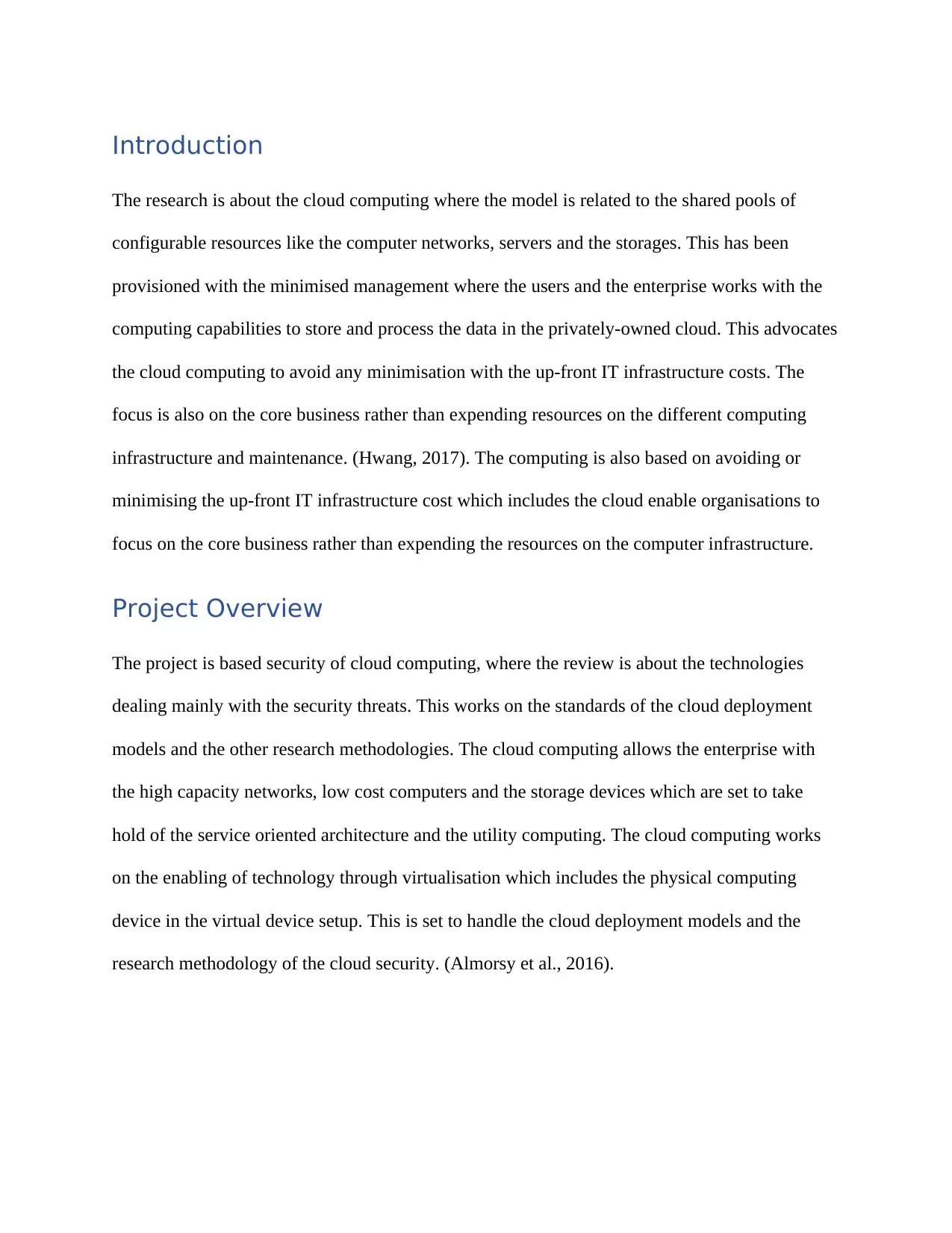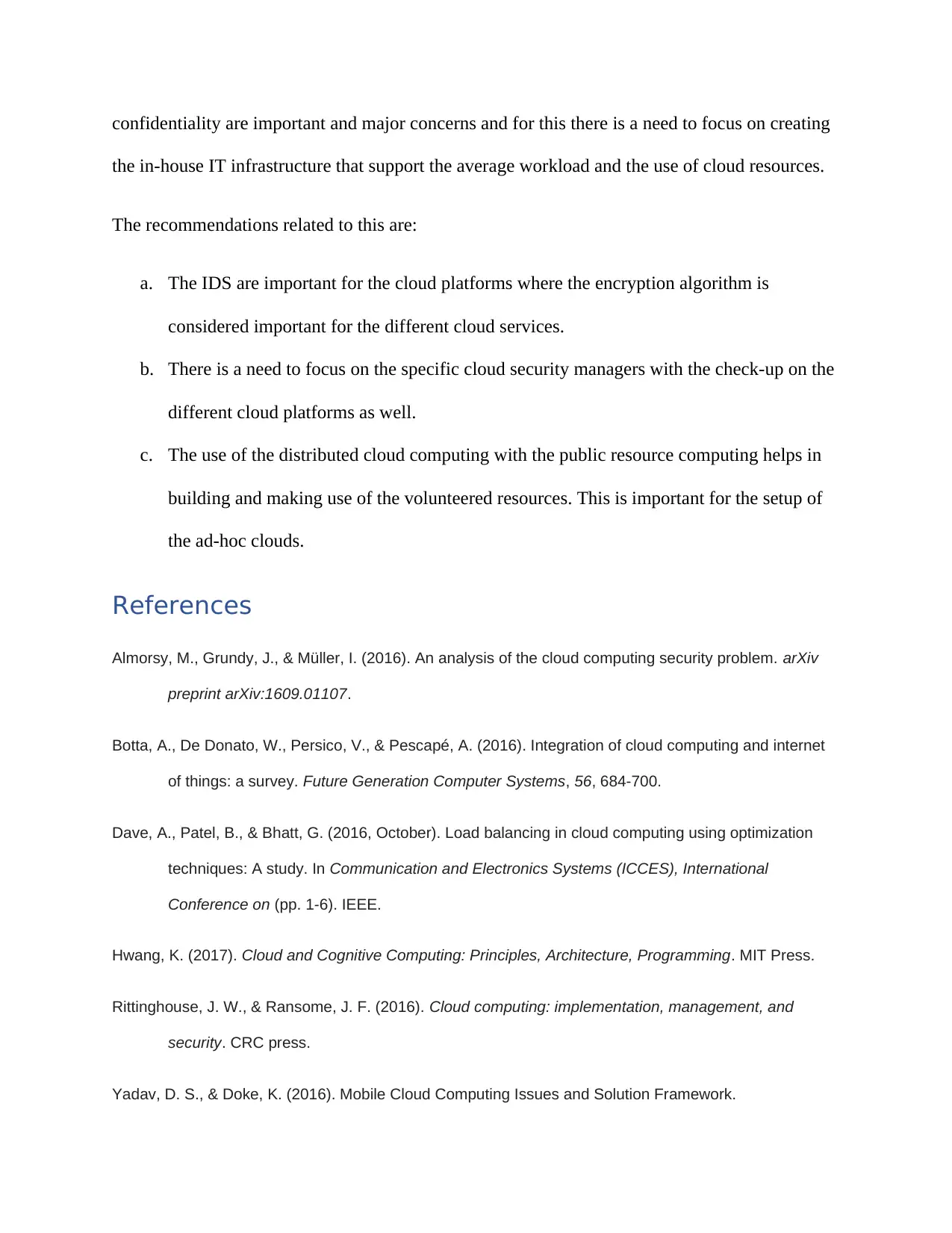Cloud Computing Security: Issues, Solutions, and Recommendations
VerifiedAdded on 2019/10/30
|7
|1255
|88
Report
AI Summary
This report provides an overview of cloud computing security, addressing key issues, related work, and proposed solutions. It highlights the importance of shared resources, virtualisation, and the challenges of data transfer and privacy. The report discusses the need for robust security measures, including intrusion detection systems (IDS) to counter DDoS attacks and data encryption. It emphasizes the significance of cloud deployment models and research methodologies in securing cloud environments. The report also explores the vulnerabilities associated with weak storage and the use of encryption/decryption algorithms to protect data. Furthermore, it discusses the impact of privacy and confidentiality concerns, recommending the use of in-house IT infrastructure and distributed cloud computing to enhance security. The conclusion emphasizes the need for cloud security managers and the adoption of encryption algorithms for different cloud services, with recommendations for IDS and distributed cloud computing.

report
Paraphrase This Document
Need a fresh take? Get an instant paraphrase of this document with our AI Paraphraser

Contents
Introduction......................................................................................................................................2
Project Overview.............................................................................................................................2
Problem Overview...........................................................................................................................3
Research Issues................................................................................................................................3
Related work....................................................................................................................................4
Solutions..........................................................................................................................................4
Conclusion & Recommendation......................................................................................................5
References........................................................................................................................................5
Introduction......................................................................................................................................2
Project Overview.............................................................................................................................2
Problem Overview...........................................................................................................................3
Research Issues................................................................................................................................3
Related work....................................................................................................................................4
Solutions..........................................................................................................................................4
Conclusion & Recommendation......................................................................................................5
References........................................................................................................................................5

Introduction
The research is about the cloud computing where the model is related to the shared pools of
configurable resources like the computer networks, servers and the storages. This has been
provisioned with the minimised management where the users and the enterprise works with the
computing capabilities to store and process the data in the privately-owned cloud. This advocates
the cloud computing to avoid any minimisation with the up-front IT infrastructure costs. The
focus is also on the core business rather than expending resources on the different computing
infrastructure and maintenance. (Hwang, 2017). The computing is also based on avoiding or
minimising the up-front IT infrastructure cost which includes the cloud enable organisations to
focus on the core business rather than expending the resources on the computer infrastructure.
Project Overview
The project is based security of cloud computing, where the review is about the technologies
dealing mainly with the security threats. This works on the standards of the cloud deployment
models and the other research methodologies. The cloud computing allows the enterprise with
the high capacity networks, low cost computers and the storage devices which are set to take
hold of the service oriented architecture and the utility computing. The cloud computing works
on the enabling of technology through virtualisation which includes the physical computing
device in the virtual device setup. This is set to handle the cloud deployment models and the
research methodology of the cloud security. (Almorsy et al., 2016).
The research is about the cloud computing where the model is related to the shared pools of
configurable resources like the computer networks, servers and the storages. This has been
provisioned with the minimised management where the users and the enterprise works with the
computing capabilities to store and process the data in the privately-owned cloud. This advocates
the cloud computing to avoid any minimisation with the up-front IT infrastructure costs. The
focus is also on the core business rather than expending resources on the different computing
infrastructure and maintenance. (Hwang, 2017). The computing is also based on avoiding or
minimising the up-front IT infrastructure cost which includes the cloud enable organisations to
focus on the core business rather than expending the resources on the computer infrastructure.
Project Overview
The project is based security of cloud computing, where the review is about the technologies
dealing mainly with the security threats. This works on the standards of the cloud deployment
models and the other research methodologies. The cloud computing allows the enterprise with
the high capacity networks, low cost computers and the storage devices which are set to take
hold of the service oriented architecture and the utility computing. The cloud computing works
on the enabling of technology through virtualisation which includes the physical computing
device in the virtual device setup. This is set to handle the cloud deployment models and the
research methodology of the cloud security. (Almorsy et al., 2016).
⊘ This is a preview!⊘
Do you want full access?
Subscribe today to unlock all pages.

Trusted by 1+ million students worldwide

Problem Overview
The overview is about the cloud computing security issues which are related to providing the
security of the system and the architectural development. The cloud computing is also for
handling the data transfer or the information where there is a chance of the security risk or the
threat. The cloud computing includes the leverage of the utility computing with providing
metrics for the different services which are used. The measured services are important for the
feedback loop and the automatic computing. The cloud computing is important for the grid
computing which includes the evolvement by the quality of service and the reliability problems.
Research Issues
The cloud computing has been defined for the computing patterns where the criteria is related to
work on the emails and the database (Rittinghouse et al., 2016).. Here, the forms are set to access
the internet connectivity with the utilisation to shift or move the data through the utmost security.
The technique is mainly based utilisation or moving of the data through the security so that there
is no loophole. The benefits related to this is that there is no need of the payment for the
infrastructure or the installation. The designing is based on the different aspects where the
architecture is set to take hold of the cloud delivery models and the delivery in the different
software services. The cloud computing is important for the different computing elements where
the architecture of cloud deployment is based on working over the IDS (Intrusion Detection
System) which is one of the best solution for the detection of DDoS attack.
Related work
The research is based on the storage of services and then working over the storage of data or
information which is not up to the mark. The weak storage is found to be crashed and there are
The overview is about the cloud computing security issues which are related to providing the
security of the system and the architectural development. The cloud computing is also for
handling the data transfer or the information where there is a chance of the security risk or the
threat. The cloud computing includes the leverage of the utility computing with providing
metrics for the different services which are used. The measured services are important for the
feedback loop and the automatic computing. The cloud computing is important for the grid
computing which includes the evolvement by the quality of service and the reliability problems.
Research Issues
The cloud computing has been defined for the computing patterns where the criteria is related to
work on the emails and the database (Rittinghouse et al., 2016).. Here, the forms are set to access
the internet connectivity with the utilisation to shift or move the data through the utmost security.
The technique is mainly based utilisation or moving of the data through the security so that there
is no loophole. The benefits related to this is that there is no need of the payment for the
infrastructure or the installation. The designing is based on the different aspects where the
architecture is set to take hold of the cloud delivery models and the delivery in the different
software services. The cloud computing is important for the different computing elements where
the architecture of cloud deployment is based on working over the IDS (Intrusion Detection
System) which is one of the best solution for the detection of DDoS attack.
Related work
The research is based on the storage of services and then working over the storage of data or
information which is not up to the mark. The weak storage is found to be crashed and there are
Paraphrase This Document
Need a fresh take? Get an instant paraphrase of this document with our AI Paraphraser

issues related to the loss of data or information. Hence, for this, there are different approaches
which are related to the security of the data systems and the other cloud networks. It includes the
encryption and the decryption of the algorithms mainly to convert the confidential message into
the cipher text (Yadav et al., 2016). The analysis is also based on working over the encryption
where the sender tends to send the data in the encrypted form. Here, the specific forms of the
data are encoded before it is uploaded to the cloud server.
Solutions
The cloud computing poses the privacy concerns which are related to policy and legislation
where the end user’s choices are for the data and how it is stored. The users can easily encrypt
the data which is processed or stored in the cloud to prevent any form of the authenticated
access. The shared technology vulnerabilities and the multi-tenancy and virtualisation are main
technologies for detecting the security issues in the cloud computing (Botta et al., 2016). The
organised models are set with allowing the different tenants to be in the specific machines. The
virtualisation works on the security threats where the significant threat is the breaching of data. It
includes the evaluation which is based on working over the different types of the data and
applications that are on the platform with no security boundaries or any form of the infrastructure
changes.
Conclusion & Recommendation
As per the literature review above, it has been seen that the cloud computing is important for the
providers to decide on the management policies and the deployment. The cloud users are limited
to the control and the management of the applications which include the data caps and the other
cloud users by allocating the bandwidth for the customers (Dave et al., 2016). The privacy and
which are related to the security of the data systems and the other cloud networks. It includes the
encryption and the decryption of the algorithms mainly to convert the confidential message into
the cipher text (Yadav et al., 2016). The analysis is also based on working over the encryption
where the sender tends to send the data in the encrypted form. Here, the specific forms of the
data are encoded before it is uploaded to the cloud server.
Solutions
The cloud computing poses the privacy concerns which are related to policy and legislation
where the end user’s choices are for the data and how it is stored. The users can easily encrypt
the data which is processed or stored in the cloud to prevent any form of the authenticated
access. The shared technology vulnerabilities and the multi-tenancy and virtualisation are main
technologies for detecting the security issues in the cloud computing (Botta et al., 2016). The
organised models are set with allowing the different tenants to be in the specific machines. The
virtualisation works on the security threats where the significant threat is the breaching of data. It
includes the evaluation which is based on working over the different types of the data and
applications that are on the platform with no security boundaries or any form of the infrastructure
changes.
Conclusion & Recommendation
As per the literature review above, it has been seen that the cloud computing is important for the
providers to decide on the management policies and the deployment. The cloud users are limited
to the control and the management of the applications which include the data caps and the other
cloud users by allocating the bandwidth for the customers (Dave et al., 2016). The privacy and

confidentiality are important and major concerns and for this there is a need to focus on creating
the in-house IT infrastructure that support the average workload and the use of cloud resources.
The recommendations related to this are:
a. The IDS are important for the cloud platforms where the encryption algorithm is
considered important for the different cloud services.
b. There is a need to focus on the specific cloud security managers with the check-up on the
different cloud platforms as well.
c. The use of the distributed cloud computing with the public resource computing helps in
building and making use of the volunteered resources. This is important for the setup of
the ad-hoc clouds.
References
Almorsy, M., Grundy, J., & Müller, I. (2016). An analysis of the cloud computing security problem. arXiv
preprint arXiv:1609.01107.
Botta, A., De Donato, W., Persico, V., & Pescapé, A. (2016). Integration of cloud computing and internet
of things: a survey. Future Generation Computer Systems, 56, 684-700.
Dave, A., Patel, B., & Bhatt, G. (2016, October). Load balancing in cloud computing using optimization
techniques: A study. In Communication and Electronics Systems (ICCES), International
Conference on (pp. 1-6). IEEE.
Hwang, K. (2017). Cloud and Cognitive Computing: Principles, Architecture, Programming. MIT Press.
Rittinghouse, J. W., & Ransome, J. F. (2016). Cloud computing: implementation, management, and
security. CRC press.
Yadav, D. S., & Doke, K. (2016). Mobile Cloud Computing Issues and Solution Framework.
the in-house IT infrastructure that support the average workload and the use of cloud resources.
The recommendations related to this are:
a. The IDS are important for the cloud platforms where the encryption algorithm is
considered important for the different cloud services.
b. There is a need to focus on the specific cloud security managers with the check-up on the
different cloud platforms as well.
c. The use of the distributed cloud computing with the public resource computing helps in
building and making use of the volunteered resources. This is important for the setup of
the ad-hoc clouds.
References
Almorsy, M., Grundy, J., & Müller, I. (2016). An analysis of the cloud computing security problem. arXiv
preprint arXiv:1609.01107.
Botta, A., De Donato, W., Persico, V., & Pescapé, A. (2016). Integration of cloud computing and internet
of things: a survey. Future Generation Computer Systems, 56, 684-700.
Dave, A., Patel, B., & Bhatt, G. (2016, October). Load balancing in cloud computing using optimization
techniques: A study. In Communication and Electronics Systems (ICCES), International
Conference on (pp. 1-6). IEEE.
Hwang, K. (2017). Cloud and Cognitive Computing: Principles, Architecture, Programming. MIT Press.
Rittinghouse, J. W., & Ransome, J. F. (2016). Cloud computing: implementation, management, and
security. CRC press.
Yadav, D. S., & Doke, K. (2016). Mobile Cloud Computing Issues and Solution Framework.
⊘ This is a preview!⊘
Do you want full access?
Subscribe today to unlock all pages.

Trusted by 1+ million students worldwide

1 out of 7
Related Documents
Your All-in-One AI-Powered Toolkit for Academic Success.
+13062052269
info@desklib.com
Available 24*7 on WhatsApp / Email
![[object Object]](/_next/static/media/star-bottom.7253800d.svg)
Unlock your academic potential
Copyright © 2020–2025 A2Z Services. All Rights Reserved. Developed and managed by ZUCOL.




